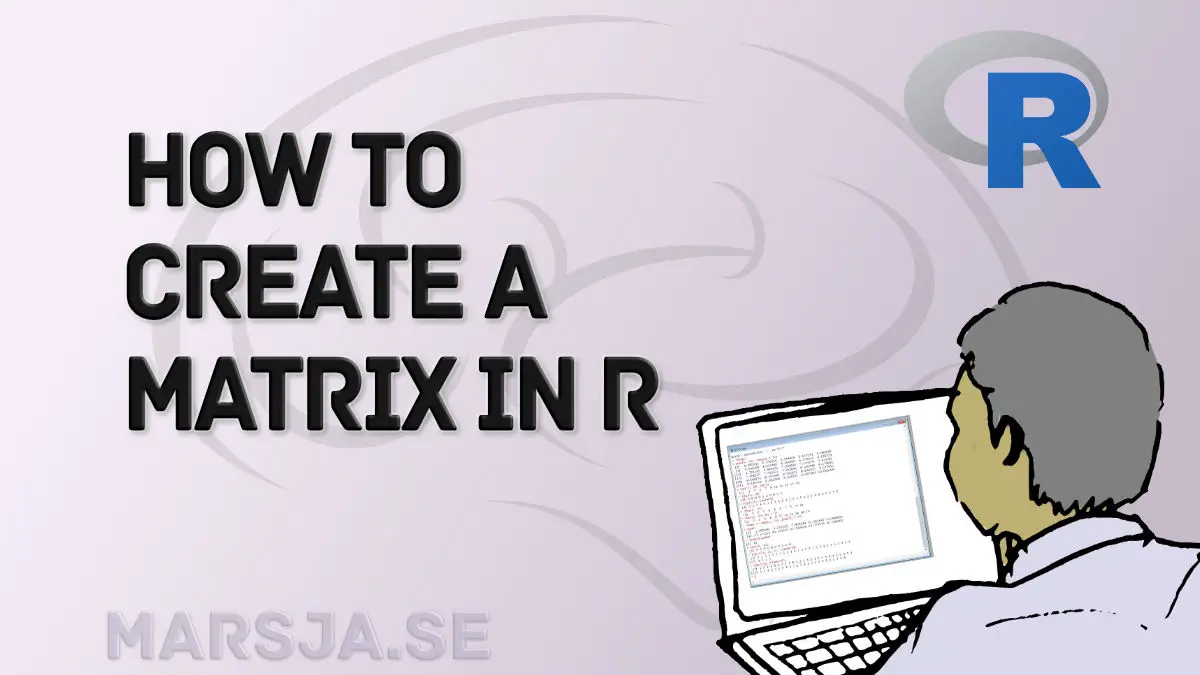In this short tutorial, you will learn how to create a matrix in R. We will use the matrix() function, among two other functions, for this aim. Specifically, we will go into the details of this function as this will enable us to e.g. name the columns and rows in the matrix we create. That is, we will look at the different arguments of the matrix() function in R. In the next section, you will find the outline of the tutorial.
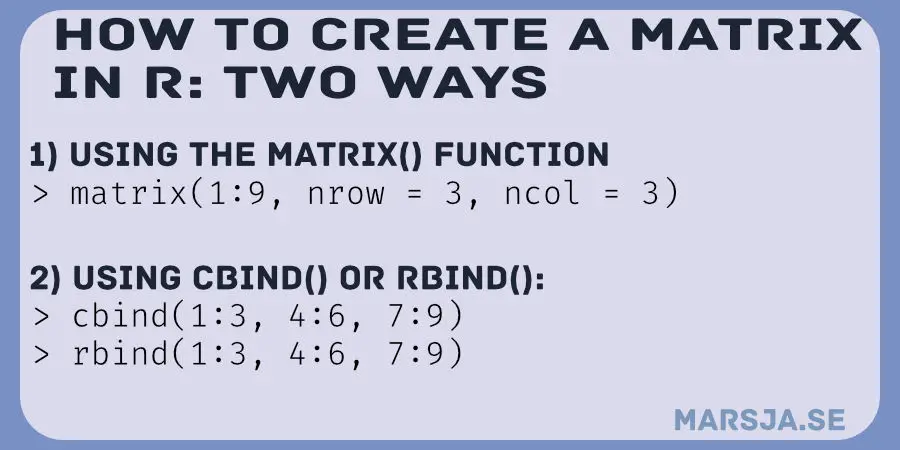
Table of Contents
- Outline
- Syntax of the Matrix() Function
- How to Create a Matrix in R – Example 1
- Example 2: Create a Matrix in R by rows
- Example 3: Create a Matrix from vectors in R using the cbind() Function
- Example 4: Create a Matrix from vectors in R using the rbind() Function
- Example 5: How to Create an Empty Matrix in R
- Example 6: How to Name the Rows and Columns when Creating a Matrix in R
- Example 7: How to Create a Matrix of Zeros in R
- Summary
- Additional R Resources
Outline
As previously mentioned, this post will cover the creation of a matrix in R by examples. In the first section, however, we will look at the different arguments of the matrix() function (the function we will use to create matrices). In the second section, we will answer the questions “what is a matrix in R?” and “how to create a matrix in R?”
After these two questions (and answers) we will continue with the first example on how to create a matrix in R. Here we will use the matrix() function when creating a matrix in R. In the second example, we will have a look at how we can use the rbind() function to combine a couple of vectors into a matrix. After this, we will use the cbind() to accomplish the same (but with a different result) and, then, the rbind() function. In these two examples, we will see how to create a matrix from vectors in R. The 5th example will show you have to create an empty matrix and the last how to name the rows and columns. In the 6th and final example, you will learn how to create a matrix of zeros in R.
In R, a matrix is a collection of elements of the same data type such as numeric, character, or logical). Moreover, these elements are arranged into a fixed number of rows and columns (e.g., 3 rows and 3 columns, 10 rows, and 2 columns). This type of data is 2-dimensional.
A matrix can be created in R using the matrix() function. For example, the following code will produce a 3 by 3 matrix: mtx <- matrix(3:11, nrow = 3, ncol = 3). Moreover, it is possible to combine vectors to create a matrix.
In the next section, you will get an overview of the matrix() function.

Syntax of the Matrix() Function
Here is the general syntax of the matrix function:
matrix(data = NA, nrow = 1, ncol = 1, byrow = FALSE,
dimnames = NULL)Code language: PHP (php)As you can see, there are five parameters that you can use:
- data – this argument is optional and will contain e.g. a vector of your data (see the previous section or the following examples).
- nrow – this argument is used to get the number of rows, you want (see the coming examples)
- ncol – this argument is, like nrow, but for the number of columns you want in your created matrix
- dimnames – this argument is used if you want to name the columns and rows (see the last example in the post)
In the next section, we will create our first matrix in R.
How to Create a Matrix in R – Example 1
Here is the first example of how to create a matrix:
mtx <- matrix(seq(1,9),
nrow = 3,
ncol = 3)Code language: HTML, XML (xml)As you can see, in the code chunk above, we used the seq() function to create a sequence in R (i.e., a vector). Moreover, we used the nrow and ncol arguments to tell the matrix() function that we want to create a three by three matrix. Here is how the matrix, called mtx, look like:
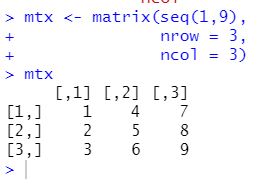
In the next example, we will have a look at how to make a matrix and set the byrow argument to TRUE.
Example 2: Create a Matrix in R by rows
Here is how we can create a matrix in R from a sequence of numbers (i.e., a vector) and get the numbers by rows:
mtx <- matrix(seq(1,9),
nrow = 3,
ncol = 3,
byrow = TRUE)Code language: R (r)Note that we can flip the order by transposing the matrix in R using the t() function (i.e., by typing t(mtx)). This would result in a matrix exactly like the one in the first example. Here is a post for more information about transposing in R:
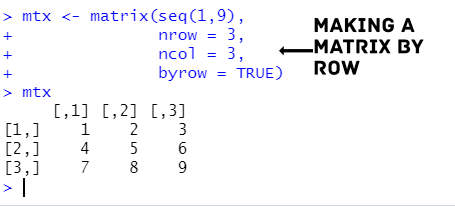
In the following example, we will look at merging three vectors into a matrix. See also the recent post on how to remove a row in R (from matrix and dataframe).
Example 3: Create a Matrix from vectors in R using the cbind() Function
Here is how to use the cbind() function to produce a matrix in R:
mtx <- cbind(seq(1,3), seq(4, 6),
seq(7, 9))Note, this method may be more feasible when we already have data stored in vectors. Here is the created matrix:
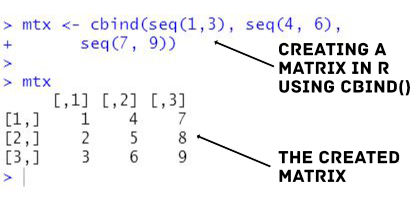
As you can see in the image above, we get the exact same result as in the first example. In the next example, before returning to using the matrix() function, we will have a look at
Example 4: Create a Matrix from vectors in R using the rbind() Function
Here is how to use the rbind() function to make a matrix from vectors in R:
mtx <- rbind(seq(1,3), seq(4, 6),
seq(7, 9))As with the cbind() method for creating a matrix it might be more useful to create matrices this way when we have data in vectors, to begin with. Here is the created matrix:

Again, this method created the exact same matrix as in example 2. In the next example, we will look at how we can create an empty matrix in R.
Example 5: How to Create an Empty Matrix in R
HEre is
empty_matrix <- matrix(nrow = 4, ncol = 4)Code language: HTML, XML (xml)As you can see, we skipped the first argument (i.e., data) this time. However, we did create an empty 4 by 4 matrix, and Here is the result:

It is now possible to fill this empty matrix with data (i.e., calculations). In the next example, we will look at how we can name the rows and columns when creating the matrix.
Example 6: How to Name the Rows and Columns when Creating a Matrix in R
Now, to name the rows and columns when creating a matrix we use the dimnames argument:
mtx <- matrix(seq(1,9),
nrow = 3,
ncol = 3,
dimnames = list(c("1", "2" ,"3"),
c("Vector", "List", "Matrix")))Code language: PHP (php)In the code chunk above, we named the rows something straightforward: 1, 2, and 3. Just for fun, we called the columns “Vector”, “List”, and “Matrix”.

In the next, and final example, you will learn how to generate a matrix of zeros in R.
Example 7: How to Create a Matrix of Zeros in R
Here is how we can create a matrix of zeros in R:
mtx_zeros <- matrix(rep(0, 9),
ncol = 3,
nrow = 3)Code language: R (r)In the code chunk above, we used the rep() function in R to repeat the number zero 9 times. This enabled us to generate a matrix populated by zeros. Here is the result:
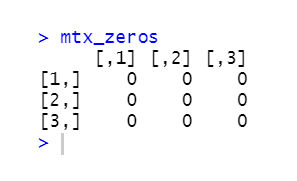
For more information, see the documentation of the different functions used in this tutorial:
- matrix() function
- rbind() and cbind() functions
Now that you have your data in your matrix you can calculate the five-number summary in R, create a violin plot in R, or make a scatter plot in r, for example. Moreover, you can also convert the matrix to a data frame.
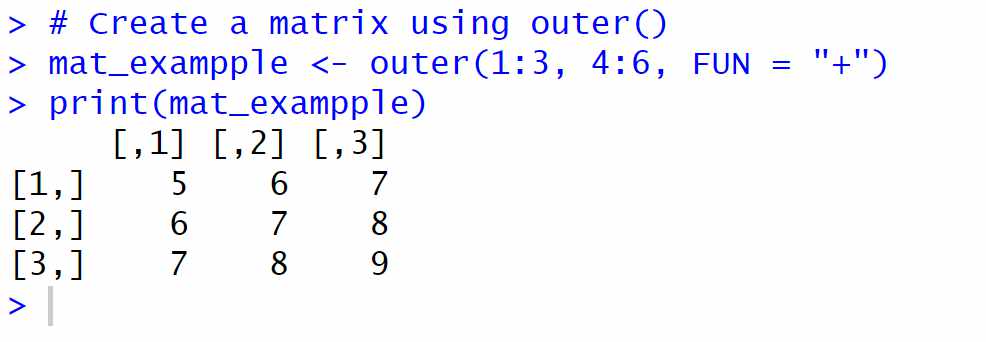
Summary
This post taught you how to create a matrix in R. More specifically, you have learned by six examples. First, we had a quick look at the matrix() function and its syntax. Second, we answered some questions. Additionally, you have learned how to make a matrix by the examples. First, we just created a 3 x 3 matrix using a sequence of numbers and the nrow and ncol arguments. Second, we used the byrow argument to get a slightly different matrix. In the third and fourth examples, we used the cbind() and rbind() functions, respectively. This was followed by learning how to create an empty matrix in R and how to name the columns and rows when creating the matrix. I hope you learned something. If you did, please share the post on your social media accounts and leave a comment below. Additionally, if there is something you want to be covered on the blog, leave a comment or contact me.
Additional R Resources
Here are some other blog posts that you may find useful:
- If you need to change the variable names you can rename columns in R with dplyr
- How to Sum Rows in R: Master Summing Specific Rows with dplyr
- When your data is stored in lists, you can convert a list to a data frame in R using the dplyr package
- How to Extract Year from Date in R with Examples
- Binning in R: Create Bins of Continuous Variables
- How to Concatenate Two Columns (or More) in R – stringr, tidyr
- Correlation in R: Coefficients, Visualizations, & Matrix Analysis
